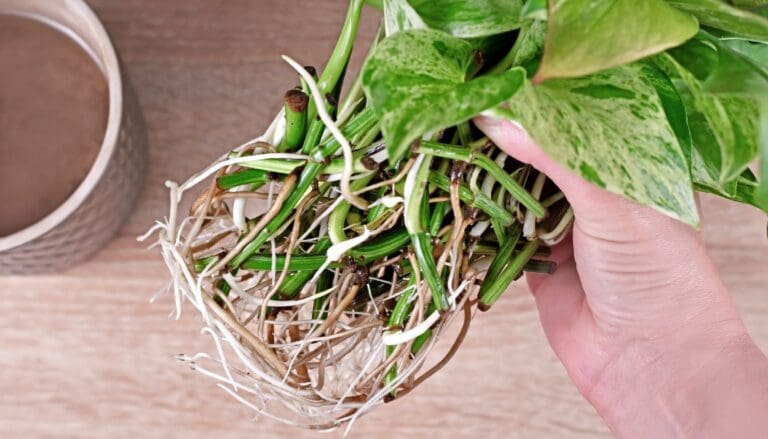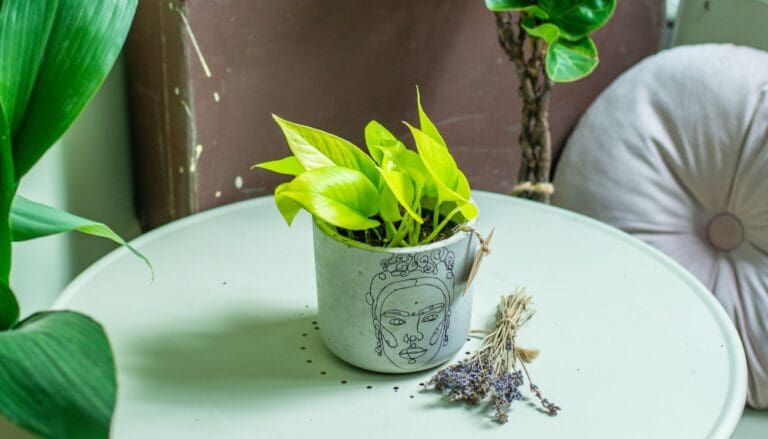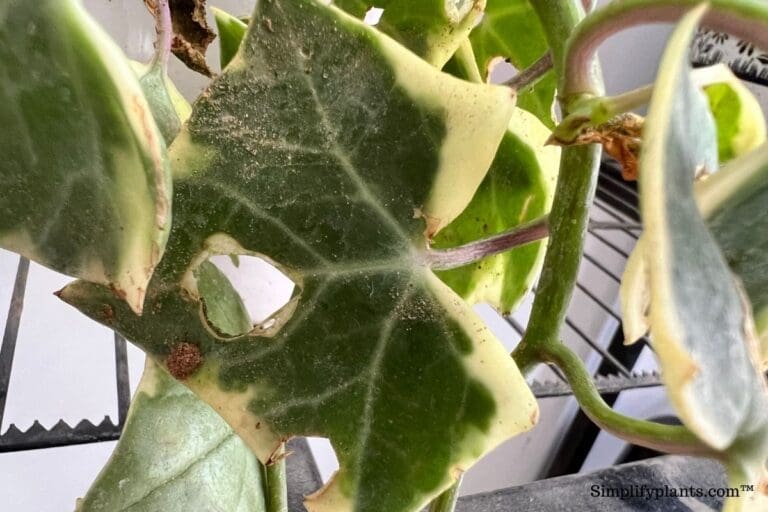9 Reasons Why Your Croton Plant Is Dropping Leaves
Crotons are primarily famous for their colorful foliage, which provides a stunning look to the house. But it hurts when you see your plant dropping all of its leaves and losing its charm.
So, one question that might come to your mind is why is my croton dropping leaves? Let’s find out.
Improper watering, inadequate lighting, pest problems are the common problems due to which your crotons might be dropping their leaves. Water the plant adequately and keep the soil moist but not soggy. Also, keep the plant in bright light and look out for possible pest infestation.
This article will discuss every possible problem behind why your crotons might be losing their leaves and how you can fix it without getting worried. Go through every bit of this article properly to make your crotons healthy again.
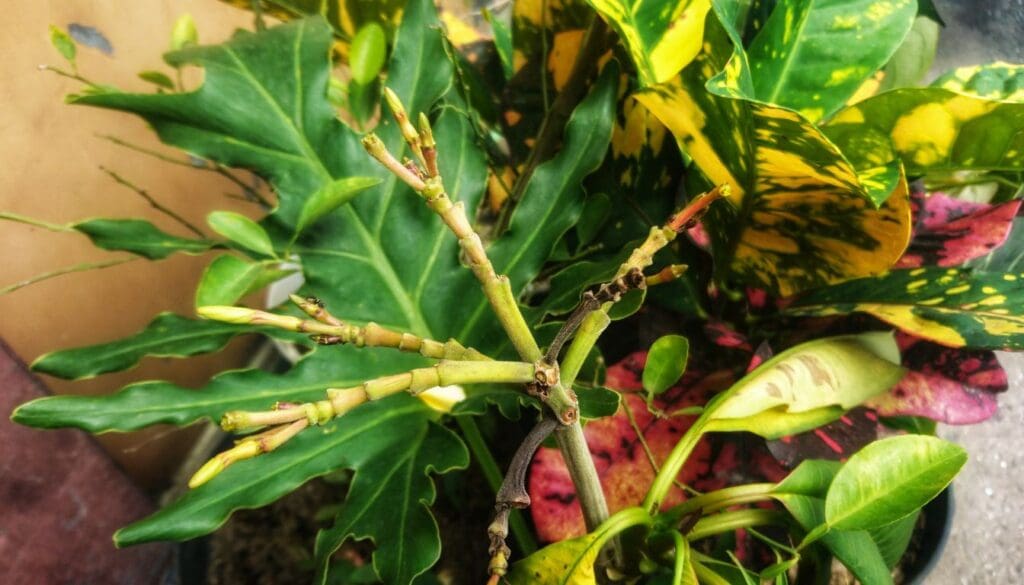
Please note: Simplify Plants is reader-supported. Some links in the post are affiliate links and I get a commission from purchases made through links in the post.
Why does my croton keep dropping leaves?
Not providing your crotons with proper requirements can cause sickness to your plant, which can cause the dropping of leaves.
By identifying the exact problem, you can quickly figure out the cure to fix your crotons and make your plant thrive again as it was before.
Let us see all the possible causes of dropping foliage.
- Inadequate watering
- Low humidity
- Temperature fluctuations
- Improper fertilization
- Low light
- Poor water quality
- Poor soil
- Wrong pot
- Pest infestations
These are all the possible causes. Now let’s discuss each point in detail, which will help you identify the problem.
Inadequate watering
Not watering your croton correctly can be the reason behind your plant losing all its leaves.
Both underwatering and overwatering can hamper your croton’s health equally, so you need to keep a check on how much water you’re giving the plant.
Sometimes, people become too casual about watering their plants and ignore all their basic needs, due to which the leaves start to drop.
Let us discuss the underwatering and overwatering problems in detail with the cure.
Underwatering
When crotons don’t get water for long, they become weak.
It happens because the plant fails to get the moisture and nutrients they need for obtaining energy.
Due to a lack of energy, the leaves begin to fall off.
Symptoms
If you notice that the leaves are turning dry and droopy, your croton might be undergoing underwatering.
Solution
- Provide water to your croton every 2 to 3 days if the plant is highly dehydrated.
- Soak your croton in the water thoroughly and let the excess water drain out from the pot.
- Don’t keep your croton near the heater or radiator, as the heat can evaporate the water rapidly.
- You should keep checking your croton regularly to check whether your plant needs water or not.
Overwatering
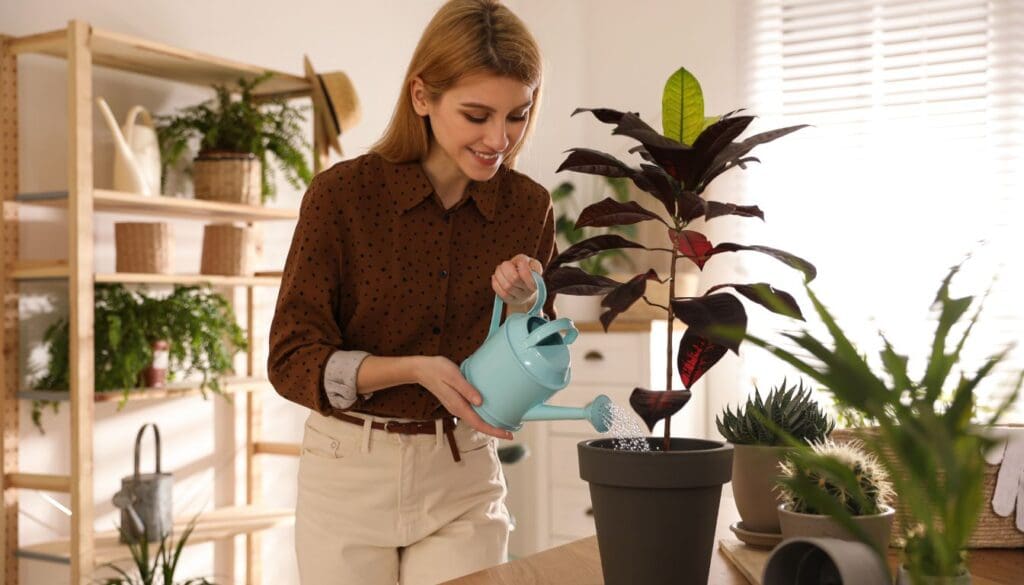
Crotons don’t like to stay in soggy soil.
Due to excess water inside the soil, it becomes tough for the roots to breathe.
In such difficulty, the roots can no longer pass nutrients and moisture to the plant, and crotons lose leaves.
Overwatering can also cause root rot disease.
Due to damp conditions, numerous kinds of pathogens and fungal diseases start to develop inside the soil, which causes root rot disease.
This problem can be very deadly to your plant and must be cured as fast as possible.
Symptoms
If you notice any yellow scars on the leaves, it may be because of overwatering.
Solution
- Before pouring water into your crotons, check the soil’s moisture level by using a moisture meter.
- If the soil is heavy, replace it with good drainage soil.
- Give your croton 6 hours of full sun to dry out the excess water quickly.
- If your croton is already experiencing any fungal disease, remove the damaged roots and repot them in a new container using a fresh potting mix.
- Don’t give water to your plant until and unless the topsoil is dry.
Also read: How Often To Water Croton Plant? (Watering Schedule+Watering Problems)
Low humidity
Since crotons are tropical plants, they need a high humidity ranging between 40% and 80%.
The minimum humidity for crotons is 40%. If the humidity drops below 40%, crotons face difficulty surviving.
As it is difficult to maintain high humidity inside the house, there is a high chance your crotons can lose their leaves because of low humidity.
Suppose the crotons are not getting enough humidity.
In that case, the leaves can lose moisture by transpiration, and the plant can get dehydrated.
When the crotons get dehydrated, the plant loses all its strength due to a lack of moisture, dropping leaves.
Low humidity problem mostly happens during the winter months, so it is essential to maintain humidity.
Symptoms
Yellowing and wilting of leaves are the symptoms you can get if the humidity level for your plant is low.
Solution
- Misting your croton with a water spray can help raise the humidity to some extent.
- Keeping other tropical plants together with crotons can also help increase humidity but avoid overcrowding.
- You can also place water trays near your crotons to raise humidity.
- You can install a humidifier to increase humidity in the room.
- Avoid keeping your plant near heating objects because the humidity is extremely low in such areas.
Also read: Do Crotons Need Misting? (+Maintaining Ideal humidity)
Temperature fluctuations
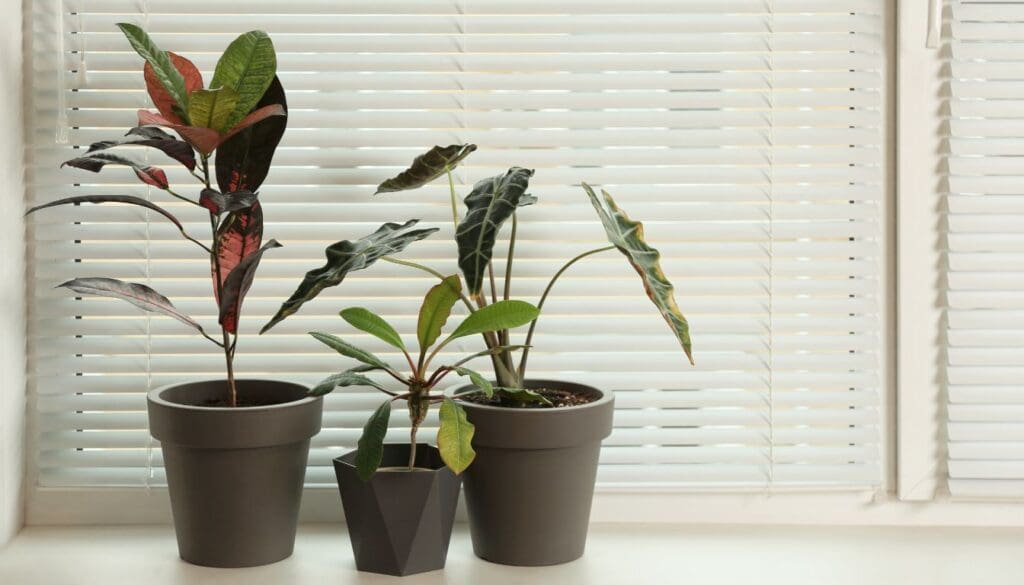
Due to sudden changes in the temperature, crotons can lose their leaves.
Extreme temperature can cause severe damage to your plant.
Crotons cannot tolerate extreme low as well as high temperatures.
Crotons can get badly injured in both conditions and start to drop their leaves.
You should try to maintain temperatures ranging between 68-90 degrees.
Suppose crotons are exposed to low temperatures.
In that case, it can restrict the water supply among the parts of the plant, which will cause nutrient deficiencies, that will lead to dropping foliage.
In the case of extremely high temperatures, crotons can suffer from dehydration, leading to the loss of leaves.
Sudden changes in the temperature can shock your crotons, so you should try to maintain the proper temperature without ignoring it.
Symptoms
Slow growth and abnormal curling on the leaves are the symptoms of a sudden change in the temperature.
Solution
- Don’t change the location of your plant often.
- Keep your croton away from chimneys, radiators, heaters, etc.
- Keep the croton in an area with good air circulation.
- Using a thermostat device can help you maintain the temperature inside the room.
- Avoid placing the croton near a window or door that is opened and closed very frequently.
- Keep your croton away from AC.
Also read: What Temperature Can Croton Tolerate? (+Ideal Temperature Range)
Low light

There are many varieties of crotons, and each variety has different light requirements.
Some crotons can grow in low light, and others may not.
Crotons can flourish best in 6-8 hours of indirect light.
Insufficient light will cause the dropping of leaves.
If your croton is not getting proper light, the process of photosynthesis starts to decline.
Without this process, crotons will not produce the energy they require, and the leaves will start to fall off from the plant.
Also, due to low light, the soil remains wet for a longer period which can invite various fungal diseases which can also kill the plant.
This problem mainly occurs during the winter months because the water does not evaporate quickly.
Symptoms
Discolored leaves and leggy growth are the common symptoms of low light.
Solution
- Keep your crotons near a south or east-facing window. This is ideal for crotons where the light is medium, not too harsh or low.
- Depending on the variety, try to provide your crotons with 6-8 hours of full sun or bright indirect sunlight.
- If the croton is not getting enough light, change the spot.
- You can also use artificial light like LED lamps, grow lights, etc.
- During winter, you can keep your croton outside for a while to provide it with adequate light.
- Always keep rotating your croton to provide light on every side of the plant.
Also read: What Kind Of Light Does A Croton Need? (Croton Light Requirements )
Poor water quality
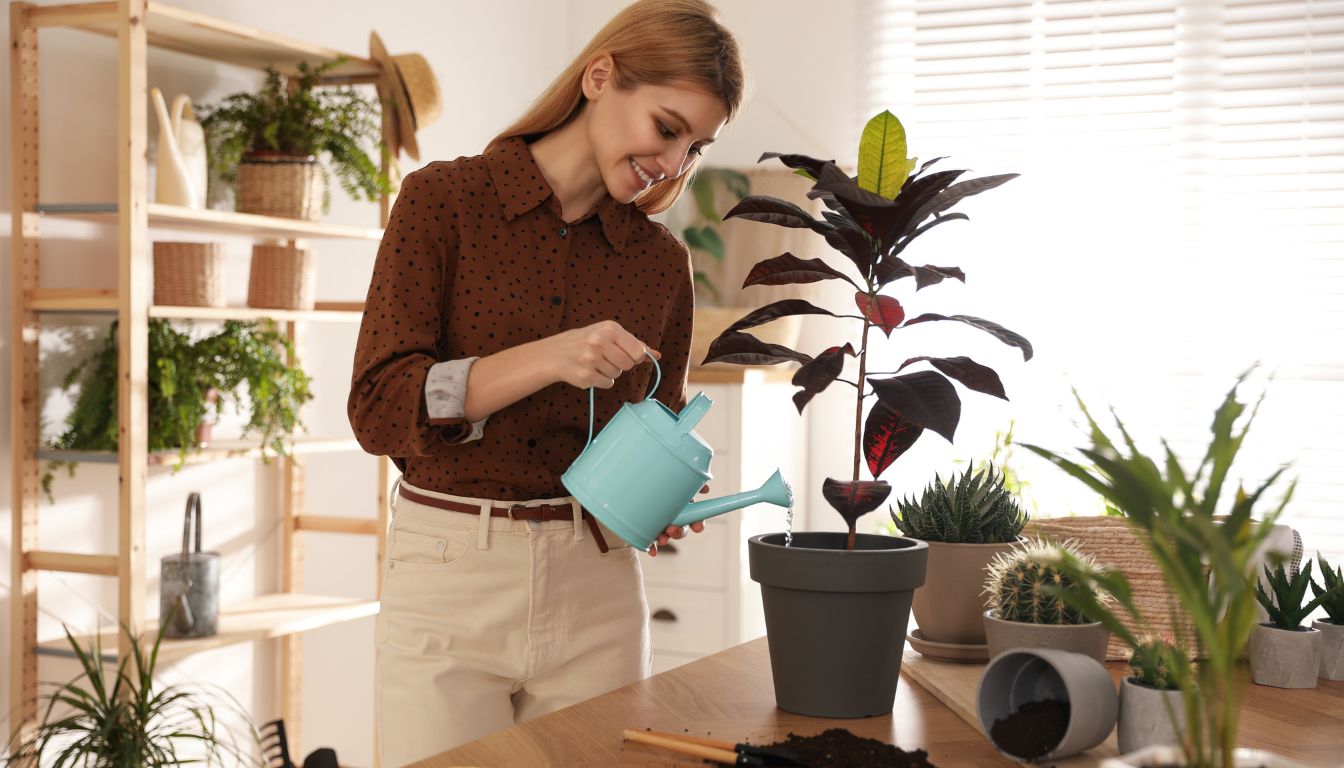
If you provide your croton with poor quality water, they can drop off leaves.
It happens because crotons are intolerable to complex and toxic chemicals.
If the water is chlorinated and contains any other minerals that are not required, it can damage the roots.
Harmful chemicals in the water can burn the roots of crotons.
Due to injury in roots, the uptake of nutrients and moisture does not occur, which weakens the plant and leads them to loss of leaves.
Avoid using tap water for watering your crotons as it contains toxic minerals like chlorine, fluorine, etc.
Symptoms
Burned leaves edges are the common symptom of poor quality of water.
Solution
- Unlike tap water, provide rainwater or distilled water as it does not have any toxic chemicals.
- If there is no distilled or rainwater, you can only use tap water after removing toxic chemicals.
- To remove toxic minerals from tap water, you should allow the tap water to sit in the container for 24 hours. After 24 hours, the harmful minerals will reduce, and then you can use them.
Improper fertilization

Both overfertilization and under fertilization can be the reasons for dropping leaves in crotons.
Lack of nutrients can restrict the growth and development of crotons.
Every plant needs a sufficient amount of nutrients to grow evenly.
Without it, the plant can get weak where leaves can start to fall off.
Meanwhile, adding too much fertilizer can damage the roots.
Because of the injury, the roots will not be able to supply water or nutrients to the crotons, and the plant will end up getting weak, and they will start to lose their leaves.
Symptoms
Brown spots and wilting of the lower leaves are the common signs of improper fertilization.
Solution
- You should fertilize your croton with a liquid fertilizer with an NPK ratio of 3-1-2 or indoor plant fertilizer.
- During overfertilization, water the soil a couple of times until it drains out. It will help to wash away all the excess fertilizer.
- Don’t fertilize when the plant is recovering. Wait for some weeks.
- If the condition worsens, repot your crotons by adding a new soil mix.
- Reduce fertilizing your plant during the winter season. Although croton doesn’t go dormant, it still rests in winter.
Also read: What Fertilizer Is Good For Croton? (Best Fertilizer For Croton Plant)
Wrong soil

The health of croton directly depends on the type of soil you use.
Incorrect soil can adversely affect the entire growth of crotons.
If your crotons grow in unsuitable soil, they can develop various serious issues.
Poor drainage of soil can cause both underwatering and overwatering problems.
As we already know, both of these issues lead the plant to lose its leaves.
Poor aeration inside the soil will lead crotons to develop fungal diseases like root rot.
It mostly happens when the soil is heavily textured.
Also, we know the soil is a good source of nutrients for plants.
If the soil lacks nutrients, it will discourage the crotons from growing correctly.
If the soil has any of the problems mentioned above, then crotons will face trouble in their growth and start losing their leaves.
Symptoms
Yellow leaves and root rot are the common symptoms.
Solution
- Always choose a soil mix that supports drainage.
- The best potting mixture for croton is 30% potting soil, 20% perlite, 25% peat moss, and 25% compost.
- To improve the heavy texture of the soil, add peat moss, sand, compost, and perlite.
- If the soil is too loose, you can add a little compost to it.
Also read: What Kind Of Soil Does A Croton Need? (+Ideal Soil Mix & Requirements)
Wrong pot
Choosing an incorrect pot with a small size or poor drainage can trouble your croton’s growth.
If the pot lacks drainage holes, the croton will experience waterlogging.
Due to waterlogging, the oxygen supply among the roots becomes less, which will cause root rot disease.
Damaged roots won’t absorb nutrients, and leaves will drop due to a lack of nutrients.
In a small-sized pot, lack of space doesn’t let the roots grow any further, which suffocates the roots.
Due to suffocation, the crotons become root-bound, and they begin to lose their leaves.
Solution
- Choose a pot that contains a lot of drainage holes.
- If the container is too small, replace it with the new one. Make sure the pot should be one to two inches larger than the previous one.
Also read: What Kind Of Pot For Croton? (Pot Size, Material & More)
Pest infestations
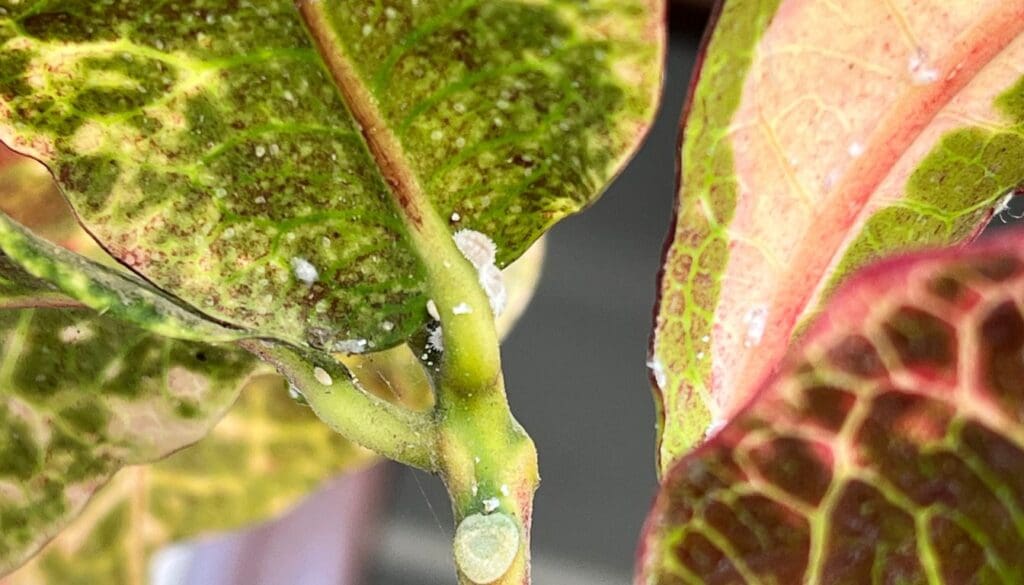
Once crotons are attacked by pests, it becomes difficult to get rid of them.
If pests keep feeding your crotons, they take out all the nutrients from the plant, making them completely weak.
Due to a lack of nutrients, the leaves start falling rapidly from the plant.
Pests not only make the plant weak but can also kill them.
Pests are often attracted due to overwatering conditions with low light or, sometimes, dry and underwatered conditions.
Symptoms
Brown spots and deformed leaves are the common symptoms.
Solution
- Spray neem oil or horticulture oil on croton and continue for 1-2 weeks.
- If the bugs are too small, you can use cotton balls to remove them. First, dip the cotton balls in isopropyl alcohol and then rub it in the infected parts of the crotons.
- While the plant is recovering, don’t keep it in an area with high humidity.
- You can also use vinegar and non-detergent soap to get rid of pests.
Also read: How Do I Get Rid Of Bugs In My Croton Plant? (Common Bugs+Fix)
Final words

If you give proper attention to your croton, you can easily prevent the loss of leaves. You just have to provide them with the correct requirements for staying healthy.
If you notice that your crotons are dropping leaves all of a sudden, don’t panic. Be patient and find out the actual cause by inspecting the plant. As soon as you find out the actual problem, try to fix it.
But remember, crotons can drop leaves at the end of their lifecycle. This is a natural process and not something that you should worry about.
Reference: Sciencedirect, Wikipedia, Wikipedia, Britannica, CABI, Academia, University of South Florida, The University of Georgia.
Recommended Garden Supplies
| Product Image | Our Recommended Gardening Supplies | Check Offers! |
|---|---|---|
Top Top
Top
Top
Top
Top
Top
Top
Top | rePotme Houseplant and Tropical Classic Potting Soil Mix | Check Offer On Amazon |
 Top
Top
Top
Top
Top
Top
Top
Top | Espoma Organic Indoor Plant Food | Check Offer On Amazon |
 Top
Top
Top
Top
Top
Top
Top
Top | GooingTop LED Grow Light 6000K Full Spectrum Clip Plant Growing Lamp | Check Offer On Amazon |
 Top
Top
Top
Top
Top
Top
Top
Top | Soil Moisture Meter | Check Offer On Amazon |
 Top
Top
Top
Top
Top
Top
Top
Top | Govee Hygrometer Thermometer, Bluetooth Enabled! | Check Offer On Amazon |
 Top
Top | LEVOIT Humidifiers for Large Room(Best For Plants) | Check Offer On Amazon |
 Top
Top
Top
Top
Top
Top
Top
Top | Upgraded DIY Automatic Drip Irrigation Kit, 15 Potted Houseplants Support | Check Offer On Amazon |
 Top
Top
Top
Top
Top
Top
Top
Top | Stainless Steel Heavy Duty Gardening Tool Set | Check Offer On Amazon |
 Top
Top
Top
Top
Top
Top
Top
Top | Bonide Insecticidal Soap | Check Offer On Amazon |
 Top
Top
Top
Top
Top
Top
Top
Top | Bonide 32 oz Spray Neem Oil for Organic Gardening | Check Offer On Amazon |
 Top
Top
Top
Top
Top
Top
Top
Top | Garden Safe Fungicide | Check Offer On Amazon |

